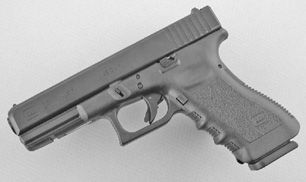Many 1911 makers offer what might be called “middle ground” guns, not their most expensive options but still incorporating all the features deemed desirable on “street” 1911s. The Glock 37 is a new player in the carry auto pistol market, chambered for the .45 GAP cartridge. We wondered (a) who made the best “street” 1911, STI or Springfield; and (b) which would give a prospective buyer the most gun, one of these mid-priced 1911s or the Glock 37?
Here’s what we found in a head-to-head match up of the STI Lawman, $1,475 .45 ACP; the Springfield Loaded .45 ACP, $829; and the Glock 37, $661.
In the April 2004 Gun Tests we reviewed the Lone Star Lawman and found it lacking in reliability due to an overly large disassembly notch. This lead to failures to go into battery on the last round out of the magazine. Shortly after our review, Lone Star went out of business — the two events were not related. Lone Star’s intellectual property and equipment were acquired by STI, which offered their own version of the Lawman. (Only STI-produced Lawman autos are covered under warranty by STI, not the Lone Star guns.)
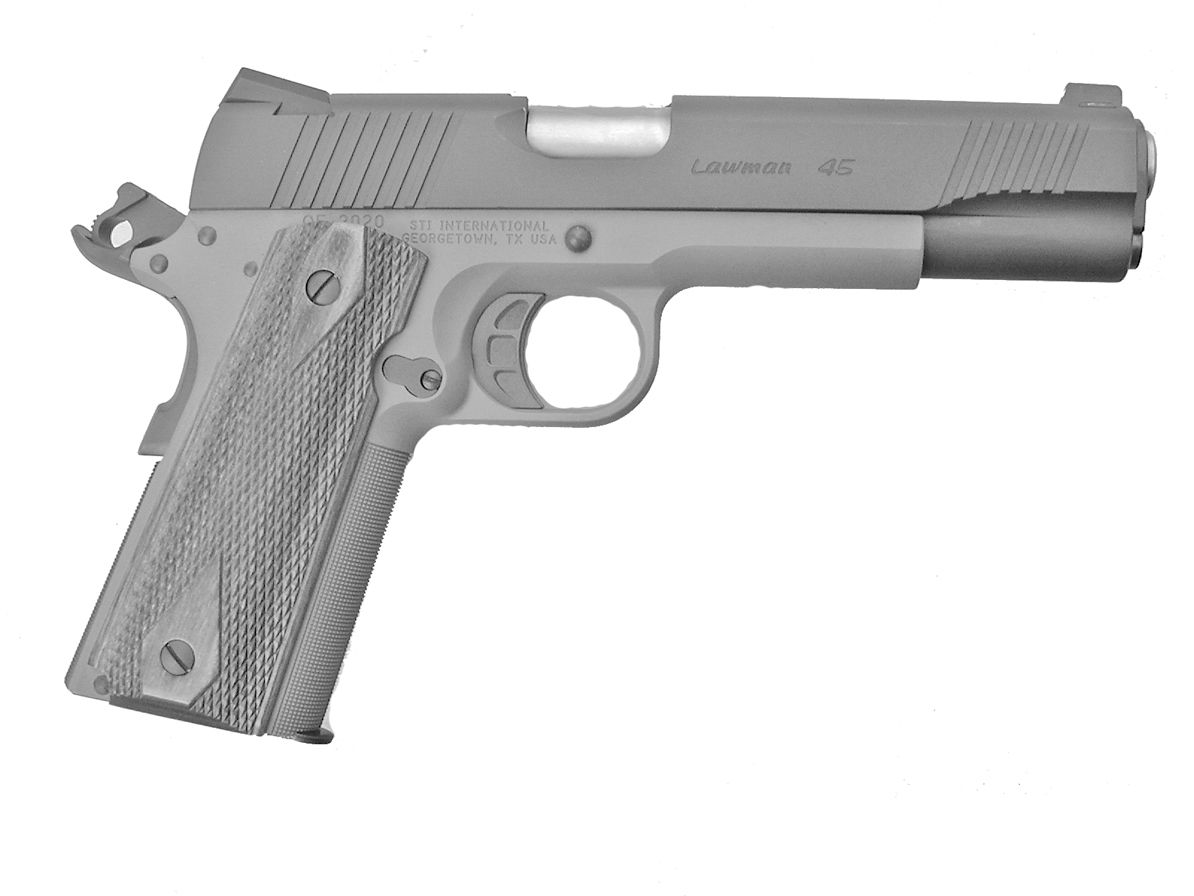
Examining the STI Lawman revealed an all-steel 1911 of the familiar Government Model pattern. The Lawman had slide-cocking serrations front and rear; a one-piece full-length recoil spring guide rod; rowel hammer; and beveled magazine well. The trigger was a “long” aluminum unit, patterned after the carbon-fiber trigger STI puts in all their other 1911s. As a matter of fact, until we fondled it, staff members thought it was the carbon fiber trigger. The thumb safety was extended but single-sided. The extractor was of the traditional pattern in preference to any of the various spring-loaded designs we’ve been seeing lately. There was no firing pin lock. The frontstrap and mainspring housing were both very nicely checkered at 30 lines per inch.
Our test gun was finished in spray-on/bake-on polymer. The slide, trigger, mainspring housing, hammer, grip safety, thumb safety, magazine release button, slide stop, and slotted grip screws were all dark brown; the frame was “tan” as STI called it — which looked to us amazingly like a light OD green. The brown slide/tan frame was the only color treatment in which this gun was available. Some people thought this color combo exquisitely beautiful, others godawfully ugly. One thing for sure, this gun’s appearance left no one unmoved! Grips were of walnut with pedestrian grain. The bead blasted stainless steel barrel was, of course, matte silver.
Out-of-the-box there was no perceptible play between slide and frame, top-to-bottom or side-to-side. Likewise no vertical or lateral movement of the barrel when pushing on it through the ejection port with the slide forward. The thumb safety, slide stop and magazine release button all operated smoothly.
Sights were fixed. The front sight was a smooth ramp .125-in. wide by .180-in. tall according to the dial calipers. Rear sight was the well-known Novak LoMount, its notch .120-in. wide by .100-in. deep. With the fat front sight and tight rear notch, the resulting sight picture was extremely cramped, with very narrow light bars on either side of the front blade. Our complaint about the Novak LoMounts over the years has always been the tightness of its rear notch. The sights featured the popular three white dot treatment.
Of significant note, the grip safety on the STI Lawman had been very well “sensitized,” i.e. while still perfectly functional it would disengage with little inward movement. This was good news for staff members using the popular straight thumbs “IPSC grip” which can sometimes fail to depress grip safeties far enough to disengage. We found it impossible to grip the Lawman lightly enough to make the grip safety malfunction.
There was quite a bit of take up to the trigger pull, about 1/8 in. Creep and overtravel were almost nonexistent, trigger reset (the distance the trigger must return forward before the trigger resets and another shot may be fired) noticeably short. The trigger broke at 4.75 pounds according to the NRA weight set, an excellent pull weight for a carry 1911, heavy enough to avoid the specter of accidental discharge, but not grotesquely heavy.
The guns are sold with one magazine (though we had more than one on hand), made for STI by Metalform. Mag bodies were blued steel; followers were rounded and also of blued steel; floorplates were flat metal with two screw holes pre-drilled to affix after-market bumper pads. Though the mag tubes were pierced with witness holes for eight rounds so the end user could switch to any of the after-market 8-round spring and follower systems, out-of-the-box they only held seven.
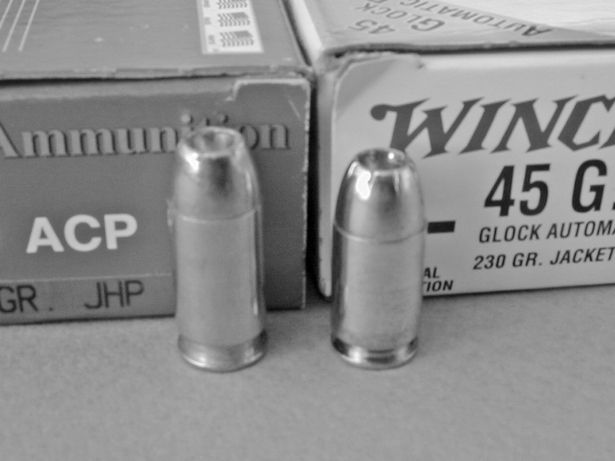
We fired a representative assortment of seven different .45 ACP loads. 230-grain hardball was Federal’s generic American Eagle, and Winchester’s BEB (Brass Enclosed Base, a “lead free” training round with a shape that could best be described as “rounded truncated cone”). Hollowpoints included Black Hills’ 185-grain, Federal’s 230-grain Hydra Shok, and Winchester’s 185-grain Silvertip and 230-grain SXT. Finally, light target loads were represented by Black Hills’ 200-grain lead semi-wadcutter.
The gun’s fixed sights proved very poorly regulated. With a center hold on target, all ammunition fired impacted 6 to 7 inches low. On our 14×14 in. square targets, several of the ammo types shot so low they wouldn’t put all five rounds on paper – one or two were consistently, totally off. Even with ammo that could get five holes on paper, we sensed we weren’t extracting the accuracy of which this finely fitted gun might be possible. From a strictly empirical standpoint, having that great a discrepancy between point-of-aim and point-of-impact shouldn’t make any difference in overall group size. You should still be able to print tight groups (granted the gun has the inherent accuracy potential, of course), they’d just all be low. In reality, there’s something dispiriting about knowing every round you fire is going to be that far from where you’re aiming that negatively affects final group size. When you see the notation “N/A” in the ammunition comparison chart, it stands for “Not Applicable” and refers to a round that wouldn’t put five holes on target.
Having said all that, we did get some decent (though hardly spectacular) groups from the STI Lawman. Best accuracy came from the Federal Hydra Shoks at 1.4 in. Black Hills lead semi-wadcutters gave us a 1.6-in. group. The Winchester BEBs went 1.7 in. And it was all downhill from there.
When we mentioned the elevation problem to the folks at STI, they instantly replied, “We know exactly what probably happened there. The Lawman’s very new to us. Some of the slides we used on the very first guns were actually made by Lone Star. On some of those guns, the rear of the slide was .040 in. low. We didn’t catch that before we made the guns, but we did catch it during final inspection. Those guns we took the slides off, cut them in two for disposal, then put on new slides – with the exception of a few display guns we had just to look pretty. That’s probably what you got: the one gun that was wrong.”
With the magazine fully loaded, the gun would not feed hollowpoints or semi-wadcutters until it was down to five rounds in the mag, after which it fed just fine. Only when loaded with hardball did the gun work perfectly when fully loaded. Otherwise, the first three rounds in the magazine would nosedive into the feed ramp.
Again, when we discussed this state of affairs with STI, they knew what was wrong: “For awhile on our Trojan line, some of our other 1911s, and the early STI produced Lawman guns, we were getting nosedive situations. We extended the ramp forward about .030 in., and it solved the problem. Now we test every Lawman with Winchester 230-grain jacketed hollowpoints and they feed just fine. If a customer has an early Lawman with that problem, they get a new barrel for free under warranty.”
Several magazines into the test, the first mag used began failing to lock the slide to the rear when empty. We switched to another magazine. The feed reliability problems persisted, the slidelock problem went away.
Whey dry cycling loaded rounds through the gun, we found the STI Lawman would not live eject hardball and semi-wadcutters. Instead the front of the bullet would hang up on the front edge of the ejection port. This would make racking a dud round out of the chamber a slow, frustrating experience.
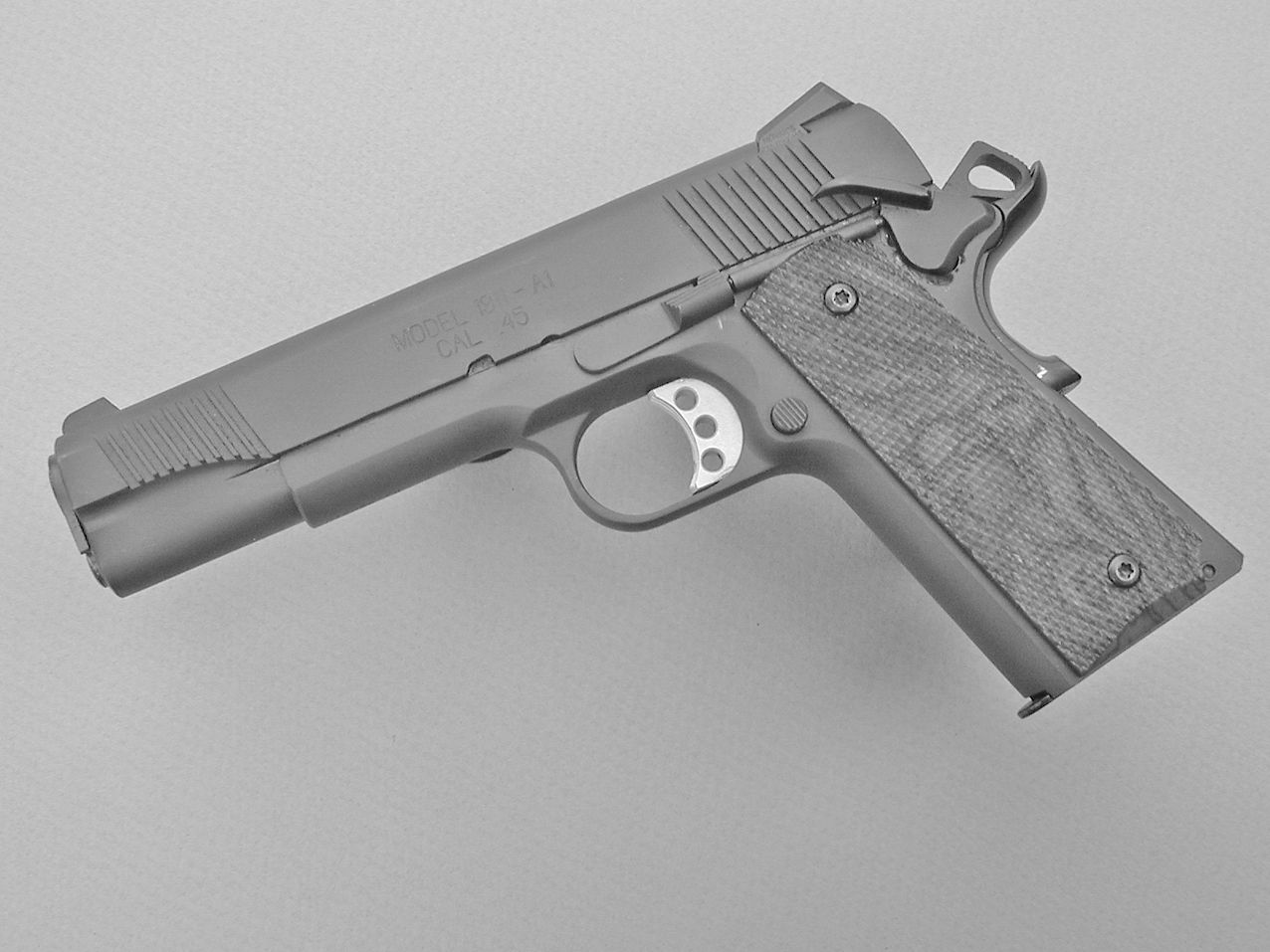
Springfield’s Loaded line was intended to provide shooters with full-featured pistols incorporating everything they could want in a “street” 1911. Loaded guns all feature low-profile fixed sights; cocking serrations front and rear; two-piece full-length recoil spring guide rod; hollowpoint compatible ramp and throat job; long match trigger; beavertail grip safety; rowel hammer; beveled magazine well; and ambidextrous safety levers of the design pioneered by Armand Swenson in which the offside lever was retained by having an extension off the front of the lever hook into a slot cut in the right grip panel.
The Loaded model was available in various finishes, the most utilitarian and attractive of which, in staff members’ opinions, was matte black Parkerizing. Our test piece was so finished. Only the “silver” barrel hood, aluminum trigger, and wood grips departed from the all-black motif. Interestingly, the barrel was a 4140 carbon steel unit with its hood polished bright but the rest of the barrel, including muzzle, was blued. Just after this article was written, Springfield began putting 416-series stainless steel barrels in their Loaded 1911s. So if you go out and buy one of these guns after reading this article, it’ll probably have a stainless barrel. Grips were beautifully figured cocobolo, held in place with hexhead screws.
Slide-to-frame fit was superior for a factory production 1911. Pushing on the slide when in battery revealed no movement from top-to-bottom or side-to-side. Pushing on the barrel hood through the ejection port showed no vertical play, however the barrel would move considerably from side-to-side.
The sights were fixed. The front blade was a serrated ramp, .125 in. wide by .185 in. tall. The rear unit was the ever-popular Novak LoMount, its notch .120 in. wide by .108 in. deep according to the dial calipers. The fat front sight and tight rear notch resulted in a cramped sight picture with narrow light bars on either side of the front blade. Sights were fitted with tritium inserts in the 3-dot pattern. Unfortunately, shortly into our testing, the front insert ceased glowing. This would of course be fixed by Springfield under warranty, but it was still a pain.
Springfield pistols manufactured after January 2001 have a “loaded chamber indicator,” so-called, consisting of a small hole in the rear of the barrel hood that, theoretically at least, allows you to look down inside the gun and tell if there’s a round in the chamber. We’ve always found such tiny holes poor substitutes for partially retracting the slide and doing a visually unobstructed chamber check.
The grip safety on the Springfield Loaded disengaged even for shooters using the popular straight-thumbs “IPSC grip,” a rarity among factory 1911s. We felt this could be traced to the shape of the grip safety itself. It incorporated a built-up pad at bottom, common on such devices these days, but also it was much more radically scalloped-out between the pad and the upper recurve, allowing the shooter’s hand to snug in much closer to the frame than on a typical 1911, thus depressing the grip safety more.
This gun featured Springfield’s Integral Locking System (ILS). Inserting a two-pronged “key” into a hole in a modified mainspring housing and turning it clockwise locked the hammer in the fully down position. Obviously this system was intended only for safe long-term storage, not as any sort of condition in which to keep a gun loaded for home defense or concealed carry. Turning the key the other way freed the hammer to move.
While operation of the ILS was simple, it considerably complicated removal and reinstallation of the mainspring housing. Four pages in the Springfield manual were given over to this procedure. Removing and reinstalling an ILS-equipped mainspring housing required cocking the gun and inserting a take down pin into the empty hole that, on a normal mainspring housing, would contain the mainspring housing cap retaining pin. An unlucky Gun Tests staff member once disassembled a current production Springfield 1911 without having the take-down pin on hand. It took three hours to get the mainspring housing back together. Many buyers of current production Springfield 1911s replace their ILS-equipped mainspring housings with non-ILS after-market units. We must give Springfield credit, however: when legal concerns dictated they incorporate some extra “safety device” into their 1911s, they did it without adding into the gun extra pins and plungers, and in such a fashion the end user could easily reverse engineer it back to straight 1911 configuration, should they desire. There’s no firing pin lock.
The mainspring housing per se was flat and serrated, not checkered as seen on many 1911s. The frontstrap was smooth and likewise free of checkering. The extractor was of the traditional pattern, none of that springloaded stuff we see so much of these days. The controls all operated smoothly, as they should.
The Springfield Loaded came with a clear plastic bag of tools necessary to field/detail strip and generally operate the piece: two copies of the ILS key, a hex wrench for the two-piece full-length guide rod, the take-down pin for the ILS mainspring housing, as well as a hex wrench for the set pin in the Novak rear sight. At Gun Tests we must confess a reactionary fondness for 1911s that may be detail stripped and reassembled using only our hands.
Trigger pulls broke at five pounds even, an excellent pull weight for a carry gun. There was very little in the way of takeup, perhaps 1/32 in., likewise very little creep. The overtravel screw could have been better adjusted as there was significant overtravel, therefore trigger reset was longer than it really needed to be. Overall though, this was a nice trigger action for a factory production 1911.
The Springfield Loaded came with one magazine, at variance to most gun companies’ policy of providing any auto pistol they sell with two mags. Perhaps Springfield realized any serious 1911 shooter already owns Wilson and/or CMC mags? The magazine supplied with the gun was a blast from the past: blued, it’s a 7-rounder with stamped sheet metal follower. Only two holes, drilled in the bottom of the magazine floorplate for the purpose of affixing a bumper pad, materially differentiated it from classic milspec.
We fired a representative assortment of eight different .45 ACP loads. 230-grain hardball on hand was Federal’s generic American Eagle, Black Hills, and Winchester’s BEB. Hollowpoints were the Black Hills 185-grain, Federal 230-grain Hydra Shok, and Winchester 185-grain Silvertip and 230-grain SXT. Representative light target load was the Black Hills’ 200-grain lead semi-wadcutter.
In terms of reliability, the gun covered itself with glory. It worked with everything: hardball, hollowpoints, target ammo; it didn’t matter, the gun fed, fired, fed again, locked its slide to the rear when empty, everything an auto pistol should do and so often doesn’t. Also, unlike most 1911s, the Springfield Loaded would live eject even long ball and semi-wadcutter rounds with aplomb, a good thing if you should have a dud round.
The worst thing that could be said about this gun is that it wasn’t particularly accurate. Best accuracy was a tie at 1.8 in. apiece between Federal Hydra Shoks and Winchester SXTs. Everything else was in the 2.0 to 2.8 in. range. The fixed sights were well-regulated from the factory, both for elevation and windage.
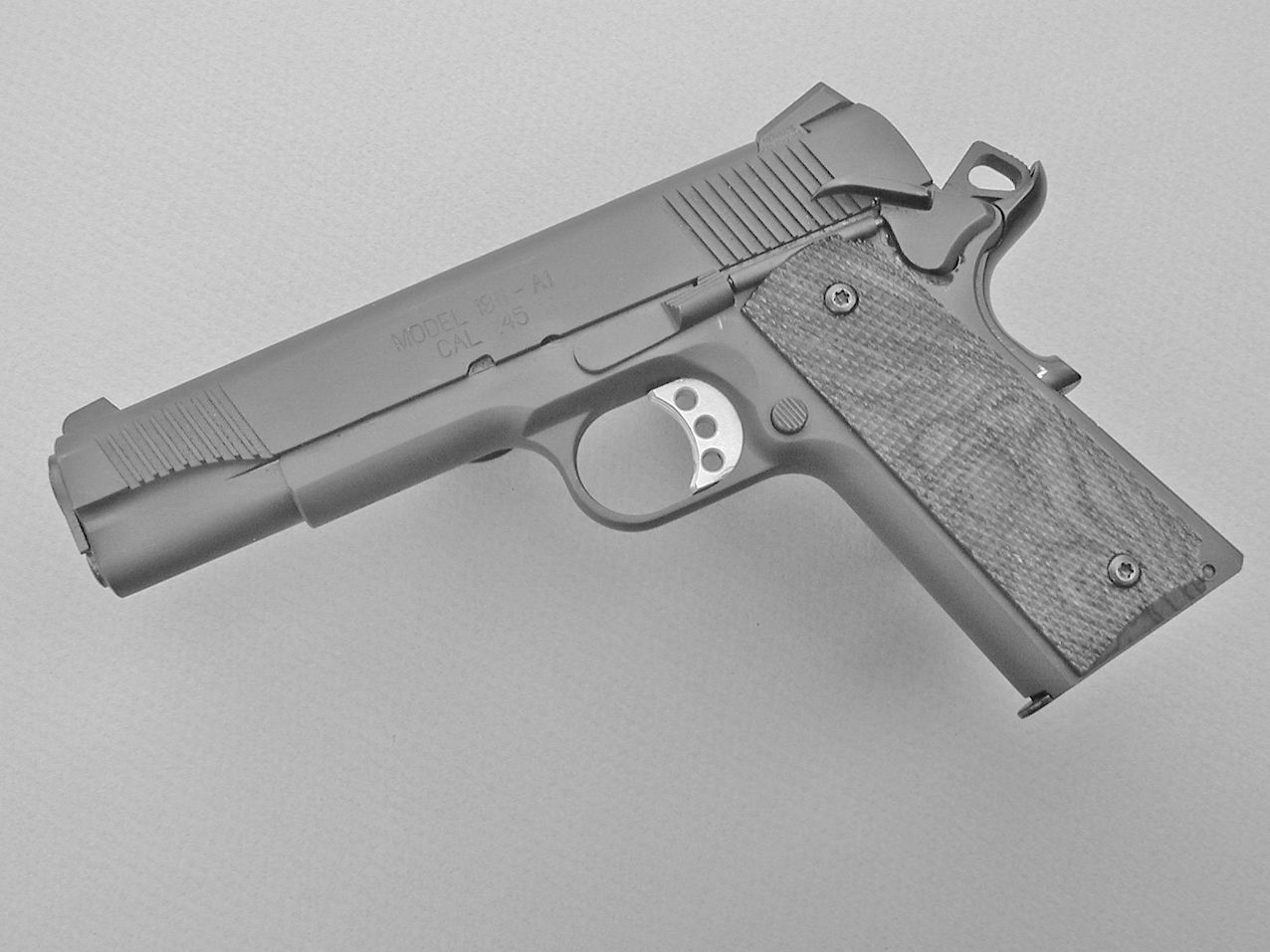
The Glock 37 was the size of a Glock 17/22/31 (albeit with a taller and wider slide) and carried 11 rounds of .45 (ten in the magazine, one in the chamber). To fit a 10-shot .45 mag into a grip the same size as the company’s medium-frame guns, Glock, in association, with Speer developed their own .45 auto cartridge, the .45 GAP (Glock Automatic Pistol). Calling the .45 GAP “a shortened .45 ACP” was unfair to Speer, and downplays what they accomplished. Speer didn’t just make a few changes to the .45 ACP and call it good, they designed their own .45 caliber auto pistol cartridge from the ground up. However, because that description of the .45 GAP did sum up its essence — a shorter cartridge launching the same bullets as the .45 ACP, we understand why people used it.
The .45 GAP was initially going to be called the .45 Glock. According to Ernest Durham, the ammunition development engineer who, working at Speer, designed the .45 GAP, there’s actually about 50,000 rounds of ammo out there with headstamps reading “.45 GLOCK”. Compared to the .45 ACP, the major difference in .45 GAP was naturally that its cartridge casing was considerably shorter, .755 in. versus .898 in. respectively. By comparison the 9mm Para casing was .754 in. long, the .40 S&W .850 in. For all practical purposes .45 GAP case length was identical to 9mm Parabellum.
The .45 GAP used a small pistol primer versus the .45 ACP’s large pistol primer. Many people have assumed the small pistol primer was used to prevent possible cartridge detonation when racking a live round out of the chamber, that the gun’s ejector might hit a large pistol primer if the round became slightly misaligned during the process. However according to Ernest Durham that wasn’t the case: for all the time people spend worrying about that possibility it’s actually a very unrealistic concern. It requires a very hard, precisely focused blow to ignite a primer (like what we get from a firing pin, amazingly enough). A nudge from an ejector as the slide was pulled slowly to the rear wouldn’t do the job. No, the reason the .45 GAP used a small pistol primer was to avoid having the stripper rail (that part of the underside of the slide that compressed the top cartridge in the magazine when the slide was forward, and stripped off the top round during feeding) from hitting the primer as the slide drove forward during the recoil cycle.
The .45 GAP, generating .45 ACP ballistics from a smaller casing necessarily operated at higher pressures, though not as much as you might think. The Sporting Arms and Ammunition Manufacturing Institute (SAAMI) set a max chamber pressure standard for the .45 GAP at 23,000 psi. By contrast for standard pressure .45 ACP, it’s 21,000, and .45 ACP +P is 23,000, identical to the .45 GAP.
Examining its internal dimensions, the .45 GAP casing was much more robustly constructed than .45 ACP. The web of the .45 GAP, as well as the amount of brass from its very base to the bottom of its interior around the flash hole, were both considerably thicker than .45 ACP. The .45 GAP had a rebated case rim (i.e. the rim was smaller than the case body) as an aid to feed reliability. As a cartridge began to feed out of the magazine, its rim didn’t drag on the cartridge below it. (An interesting piece of trivia, we think: most people don’t realize the .45 ACP is actually a rimmed casing, albeit barely. Its rim is one-half of one-millimeter wider than the case body.)
The G37’s slide was considerably taller and wider than other medium frame Glocks, so much so it was actually quite a bit wider than the frame. The G37 used the extended slide release first seen on Glock’s long slide competition models. If it had used the standard flat slide stop, the slide would overhang it so much you couldn’t reach it with your thumb.
Glock’s original plan was that the G37 be externally dimensionally identical to a Glock 17. Prototypes with a G17 size slide were built, tested and even shown at some trade shows. Eventually it was realized the slide velocity generated when you pop a G17 sized slide with .45 auto level recoil was simply too much for the high standard of feed reliability Glock demanded for their gun. They could have tried to compensate by going to a really heavy recoil spring but that would have made the gun difficult to operate. (The Glock 37 used an 18-pound recoil spring.) A better solution was simply to put more weight into the slide by making it larger.
One question many people have asked and not been able to answer: how close was the G37 butt in size and shape to other medium frame Glocks? Well, here’s the answer, straight from Glock: it’s the same frame. The frames for the Glocks 17, 22, 31, 34, 35 and 37 all come out of the same mold. They’re dimensionally identical. The only difference between the bottom half of a G37 and the other guns was a different ejector (the same part used in the .45 ACP chambered Glock 21).
Glock 37s come standard with fixed plastic sights notorious for breaking under hard use; price would be $614 suggested retail. $632 gets you a set of adjustable plastic sights even more fragile than their fixed counterpart. There are two Glock factory options for steel sights. The first, dimensionally identical to the plastic sights but made of steel, goes $636. Finally you can have those sights with 3-dot tritium inserts for $661; our test gun was so fitted, and all three lamps survived our testing. The front blade was short and fat (.168 in. tall by .160 in. wide). The rear notch was decently wide and somewhat shallow (.130 in. wide by .102 in. deep). Unfortunately, given the fat front sight, even that wide rear notch still gave a cramped sight picture with narrow light bars.
The extractor doubled as a loaded chamber indicator. When a round was in the firing chamber, the hinged extractor pivoted outward; this could be verified by sight or feel. We distrust all such devices and always partially retract the slide to do a visual chamber check even on guns so equipped.
Magazines were the same size as the Glock 17/22/etc. and would fit into closely molded pouches for same. Capacity was ten rounds. This was not one of those “military/law enforcement gets one thing, we get another” situations. Maximum capacity for this mag was ten rounds period — and it took some slick design work to get that.
Out-of-the-box the magazine springs were very stiff. Inserting all ten cartridges when the mags were new required using the supplied loading tool. After leaving the magazines fully loaded for a month, they could then be loaded without the tool, but it still wasn’t easy.
When an auto pistol magazine is fully loaded, ideally, when pushing down on the top round you want to be able to depress the “stack” about half a cartridge diameter. This ensures you could easily snap the magazine into the gun even with the slide forward. With G37 magazines by contrast there was very little compression left over. It required a serious whack with the heel of the hand to seat a fully loaded G37 10-round mag with the slide forward. Also, even though magazines were of the fully metal lined “drop free” variety, they wouldn’t drop when loaded with the full ten rounds. Pop out one round, and with nine rounds loaded when you punched the mag button they’d drop just fine.
Eventually we figured out the solution to these problems. With the magazine fully loaded, place the Glock loading tool on top of the “stack” and push downward as hard as you can. This depresses the rounds in the magazine, creating a much better stack. After that, not only would the magazine insert into the gun much more easily, it would also drop when fully loaded.
Trigger pulls went six pounds even – typical for a Glock running the standard “5.5-pound connector.” There’s approximately 1/2 in. takeup, and considerable creep, overtravel and reset distance. Don’t get us wrong, these are not bad trigger pulls unless you’ve been spoiled by much 1911 shooting. In order to find an out-of-the-box trigger action easier to shoot than a Glock, you’ve pretty much got to go to a 1911.
Three companies now produce .45 GAP ammo: Speer (four loads), Federal (one) and Winchester (four). Speer, the .45 GAP’s originator, makes 185- and 200-grain loads in both Lawman Total Metal Jacket (TMJ) and Gold Dot hollowpoint configuration. Federal has a 185-grain Hydra Shok. Finally, Winchester produces a 230-grain Winclean BEB (Brass Enclosed Base, a “lead free” training round), 230-grain Full Metal Jacket (FMJ), 230-grain jacketed hollowpoint (JHP) and 185-grain. Silvertip. Of the nine existing loads we tested eight. Speer had none of their 185-grain TMJs available at the time of this article.
Speer initially felt there was no way to load a 230-grain bullet in .45 GAP; the heaviest bullet weight possible was 200 grains; the necessarily longer 230-grainers would cause case bulging. Winchester solved that problem by changing the internal case dimensions. Inside Winchester .45 GAP brass the point at which the casing begins to angle in to form the web (called by Winchester the lead-in) starts slightly lower, thus 230-grain bullets could be seated without case bulging.
Overall this was by far the most accurate gun tested. Still not match quality accurate, mind you, but decent. In an upcoming evaluation of .45 GAP ammunition, our test gun didn’t post quite as good groups (which just goes to show, sometimes human beings can fire more accurately than a Ransom Rest). Best accuracy from the G37 came with Federal Hydra Shoks at 1.2 in. Only slightly larger were the Speer 200-grain TMJs and Winchester 185-grain Silvertips, both at 1.3 in. Speer 200-grain Gold Dots gave 1.5 in. The 185-grain Gold Dots and Winchester 230-grain JHPs were tied at 1.6 in. The Winchester 230-grain BEBs and 230-grain FMJs were 2 and 2.2 in. respectively. Winchester ball was by far the least accurate ammo in the G37 at 3.2 in. for its best effort.
For purposes of accuracy comparison with the other two test guns chambered for .45 ACP, fortunately Winchester makes a 185-grain Silvertip in both .45 ACP and .45 GAP. Winchester makes 230-grain hollowpoints in both cartridges. Granted the .45 ACP load is their excellent SXT, and in .45 GAP it’s a standard JHP in their “white box” line. Finally, 230-grain hardball was available in both cartridges; we fired American Eagle in .45 ACP and Winchester in .45 GAP. See the accompanying chart for full comparison info.
Groups were excellent for elevation, either spot-on or in some cases just slightly high. The fact the G37’s front/rear sight heights were so well adjusted out of the box for point of impact/point of aim shows Glock was really paying attention. As to windage, every group fired hit about 1 inch left. This could have been rectified by tapping the G37’s rear sight to the right in its dovetail.
Feed reliability was flawless. The gun fed, fired, ejected, locked its slide to the rear when empty, everything an auto pistol should do, every time. Given the basic Glock design’s cavernous ejection port, it came as no surprise the gun would easily live eject anything we loaded into it.
Gun Tests Recommends
• STI Lawman, $1,475. Don’t Buy. The STI Lawman was very smooth and built to exacting tolerances. Unfortunately, our test gun’s fixed sights were poorly regulated for elevation, a situation apparently occurring on early STI Lawmen using Lone Star-produced slides. The gun would not feed hollowpoints or semi-wadcutters unless the magazine was downloaded to five rounds. It was reliable with a full magazine only with hardball. The gun would not live eject hardball or lead semi-wadcutters. According to STI, the feed reliability problem could be traced to feed ramp dimensions in early production guns since rectified. We look forward to testing a more current production STI Lawman in the near future.
• Springfield Loaded, $829. Buy It. The Springfield Loaded was totally reliable in our testing. It would handily live eject any sort of ammo you could load into it. The fixed sights were well-regulated and incorporated tritium low light inserts, although one of the lamps did not survive our testing. The grip safety disengaged even for shooters using the straight-thumbs “IPSC grip,” a rarity among factory 1911s. Trigger pulls were decent, and the controls all operated smoothly. That the gun wasn’t particularly accurate stops us from making it Our Pick. A shooter wanting a reliable 1911 for defense and/or carry could do a lot worse than choosing this one.
• Glock 37, $661. Buy It. The Glock 37 did exactly what it set out to do: fit 11 rounds of .45 into a gun of “normal” dimensions, both overall and in the size of the grip. Our test gun was totally reliable. It was the most accurate gun tested. A fairly light gun chambering a vigorous cartridge, this was not the best choice for the recoil conscious. While we don’t believe the Glock 37 will take a big bite out of the 1911 .45 market, for some buyers the Glock 37 will prove a superior alternative to the 1911. Many folks aren’t bound to a single design, but they do love that .45 caliber. For such people it would come down to this: they could pay up to thousands of dollars for an 8 or 9-shot (assuming an 8-round magazine and one in the chamber) single-stack 1911 .45 that might or might not work out-of-the-box. Or they could pay less than $700 for an 11-shot Glock 37 that worked.




























